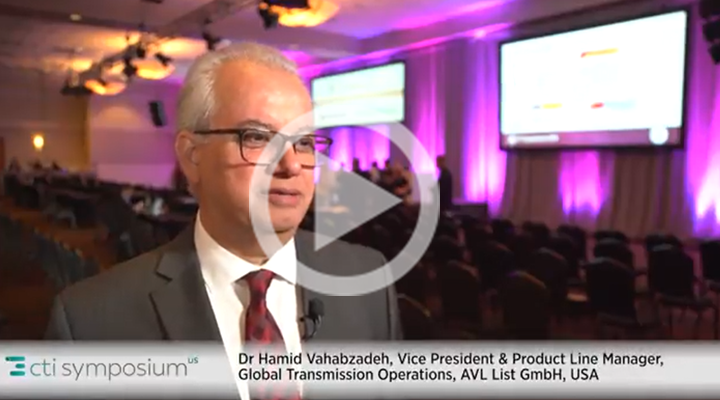
Dr Hamid Vahabzadeh, Vice President & Product Line Manager Global Transmissions at AVL List GmbH USA.
The automotive industry is transforming and disciplines are intertwining more and more. This challenges OEMs and suppliers who try to keep pace with the developments in all areas. Dr. Hamid Vahabzadeh has been chairman of the CTI Symposium for many years now and witnessed the changes in the industry. We talked to him at the Symposium, which was part of the CTI Automotive Week this year, to take the current changes into account.
CTI: Mr. Vahabzadeh, you’ve been the chairman of the CTI Symposium for many years now – what’s this year’s highlight in your opinion?
Hamid Vahabzadeh:Well, this year is quite a bit different because we have combined the different conferences together in the same venue to increase the interaction and networking among the different disciplines in the automotive industry. From this aspect it provides a much larger opportunity for the attendants to interact among different disciplines and look at the interaction of the technology between these different disciplines. For example, autonomous driving and connected vehicles would have a huge impact on the transmission technology in terms of its operation and the requirements for transmissions and electrification needs. And this new platform that we have formed here really provides the discussion for preparing for the next generation of technologies in transmissions as well as enabling some technologies such as autonomous driving.
CTI: You said it already the CTI automotive week extends the variety of topics further. What was the motivation for this step?
Vahabzadeh: As I just mentioned it’s really the enhancement of the interaction and the wish of providing a basis for all of the experts in the field to enable them to interact and exchange ideas. Look at some of the most difficult issues now, in which they need to get a head start in resolving, and perhaps this provides a basis for some additional collaboration between the different companies working on different technologies so that we can increase the speed of development in these technologies.
CTI: At AVL you have been pushing hybridization and electrification for many years. What kind of additional knowledge does a leading engineering service provider need today and in the future?
Vahabzadeh: Well at AVL we try to be always at the leading edge, at the front end of the technology development. We put an awful lot of effort and R&D resources into developing brand new technology especially in the area of electrification, field service technology, transmission, new power train concepts And now we are getting to the autonomous and connected vehicle and this is the area where we are really trying to be at the leading edge, being able to help our customers and our partners for improving the products and getting ready for the next generation products. This is one of the roles that AVL has taken and by putting a lot of internal resources, funding and R&D we try to push that technology.
CTI: And how should this be reflected in the education of young engineers?
Vahabzadeh: Well, I think for the students and new engineers who need to get educated in a wide variety of disciplines and new technology areas in the basics of engineering all of the fundamentals, and then be able to focus in the particular areas of their interest, it’s really a difficult task. Now to help them along we need to engage them in the industry early on by providing them with project opportunities, providing internships for them, so that they can come into the industry and learn first-hand by working on projects and learning the latest issues and technologies. Carrying that experience back to school they can benefit from this additional education and learning.
CTI: Given the rising complexity and interdisciplinary approaches – how do you see the future role of car transmissions?
Vahabzadeh: Well, the car transmissions are going to experience a significant transition. In fact, there has been an evolution of conventional transmissions to a wide variety of transmission technologies to the electrification of transmissions now. And I think the last step is going to be pure electric transmissions. Of course, it’s going to take some years, but I think this transition is eventually going to happen. Now many companies have already completed their transition to the electrified transmissions or hybrid technologies and have now started to work on pure electric drives or e-axles. Some companies have taken advantage of this opportunity by completely bypassing the hybridisation. They jumped directly from conventional IC engines to pure electric drives, and again, it depends on the product strategy, it depends on the market segment that they are playing in. They know the customer base and the customer needs and picking different options. One thing that is certain is that there is not really a silver bullet solution, all of these transmission technologies will be viable for the foreseeable future and they will coexist for a long, long time. The volumes can change depending on the application and the different markets and global regions but nevertheless I truly believe that all of these technologies will coexist and will continue for a long time.
Interview by Andrea Hanninger
 Dr Hamid Vahabzadeh is Vice President & Product Line Manager Global Transmissions at AVL List GmbH USA. He has been the chairman of the CTI Symposium USA for many years.
Dr Hamid Vahabzadeh is Vice President & Product Line Manager Global Transmissions at AVL List GmbH USA. He has been the chairman of the CTI Symposium USA for many years.
Get all info’s about the upcoming CTI Symposium China
